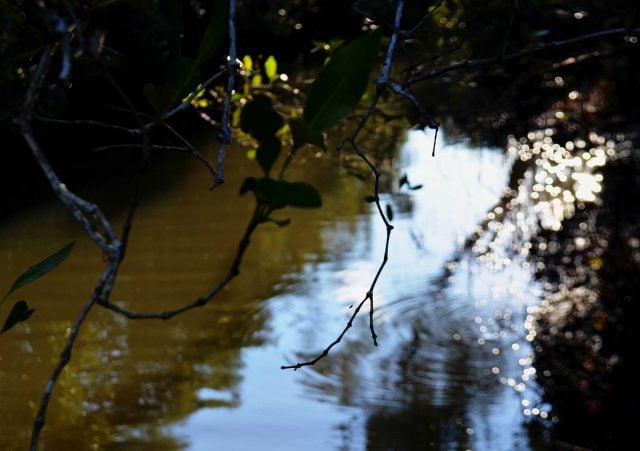
It’s not a done deal. The swamplands that define Byron Bay are crippled but still alive. The NSW Joint Regional Planning Panel is still debating how mega-development of West Byron might harm the Cumbebin Nature Reserve and the Belongil waterway. But the ecological powerhouse that includes these sites is a force to be reckoned with. It is only satisfied with water. We all live with this. That’s why it’s important that each of us make submissions to Byron Council by 29 March.
What we know is what the decision-makers need to hear.
The Belongil waterway is three kilometres long in a catchment of approximately 3,000 hectares. Think of each hectare as the equivalent size of a rugby football field. Over 1,000 hectares of the Belongil catchment is swamp.
From 1870 to 1920, more than a hundred kilometres of drains dug from Lilli Pilli to Tyagarah tried to make decent hard dry land of Byron Bay. What looks like proper paddocks, paved roads and solid buildings are simply various works on degraded wetlands. As we all know, what with rain and tides, flooding persists to this day.
Since 1999, 40 hectares of wetlands were protected as Cumbebin Nature Reserve. In 2008, the Arakwal Indigenous Land Use Agreement extended protection so that by 2012 the reserve totalled 91 hectares. Since 2006, the Cape Byron Marine Park includes the Belongil waterway itself. The idea was that these legal zones would safeguard all that wet ecology.
Cumbebin and Belongil work together. Wet places have murky edges that shift and change. In these damp to soggy places grow tallowwoods, paperbarks, casuarinas and mangroves. These branches and leaves are shelter and food for the familiar koala, water dragon and the coastal and migratory birds.
The leaves, bark and roots of trees plus the sedges and grasses and all the microbes active in the Cumbebin-Belongil complex also support aquatic wildlife. As the water levels vary with rain and tide, the juvenile and adult fish and prawns move in and out. They wander, feed, chase, escape and play in the shallows and depths.
Seafood basket
Such complexes are very productive. Recently, ecologists weighed small fish who travel to feed in these shallows. The first weighing was as they came in with the tide. The second was as they left. With each tidal cycle, their weights doubled.
The size and quality of these overall complexes are important too. In the living memory of some of our residents, the Cumbebin-Belongil was part of a larger seafood basket. It offered an abundance of fish, prawns and shellfish.
This basket is rather empty now because ever fewer aquatic animals found ever poorer conditions. While very heavy fishing was under-way, the extent of the complex was reduced and degraded. Water became polluted. The flow changed.
To clean water and refill the food basket, we need to protect and restore more of the original 1,000-hectare swamp. Imagine a Cumbebin-Belongil-West Byron complex.
Instead, on offer in West Byron are two mega-development proposals. They include 2.1 hectares of wetlands. On the borders of the two proposed sites are another 96 hectares of wetlands. All will be degraded, not enhanced.
To try to make decent dry land at a height above flood level, some of West Byron will be smothered with a million tonnes of fill. Some of the degraded wetlands will be bulldozed. A lot of it will be polluted. Farewell frogs. Goodbye hungry fish. Never mind hungry people.
Creating fish kills
West Byron also has a mosaic of degraded wetland with acid sulfate soils. When these are disturbed by works, their chemistry creates sulphuric acid. These seep throughout the site and into the Cumbebin-Belongil. Hello fish kill.
So tell the government that, on top of all the other issues, you care about the Cumbebin-Belongil complex. It’s not the best now but it won’t improve as a result of these proposals.
It’s not a done deal. These proposals could be much better. In January, Wildlife Trust (UK) published Homes for people and wildlife. They insist that ‘all housing developments must result in measurable improvements for wildlife and habitat’ plus ‘all residents have lasting access to nearby nature’.
The Cumbebin-Belongil-West Byron complex must include growth plans for wildlife. Rehabilitating more of our 1,000-hectare floodplain would help refill the food basket. It would also create a life worth living for people too. Isn’t ‘lasting access to nearby nature’ what Byron Bay is all about?
♦ Homes for people and wildlife




SHUT THE GATE THE BLOW-INS & THE GREEDY OPPORTUNISTS HAVE TAKEN CONTROL
IT’S A HAS BEEN NOW BYRON!
BIGGEST SHAME ON THE NORTH COAST
AND AS FOR THAT MAYOR!!!! GRIMACE!!!
I’VE LIVED ON THE NORTH COAST ALL OF MY TEENAGE & ADULT LIFE & BYRON IS COMPROMISED NOW!!!! Backpackers playground
Was once great is no more!!!